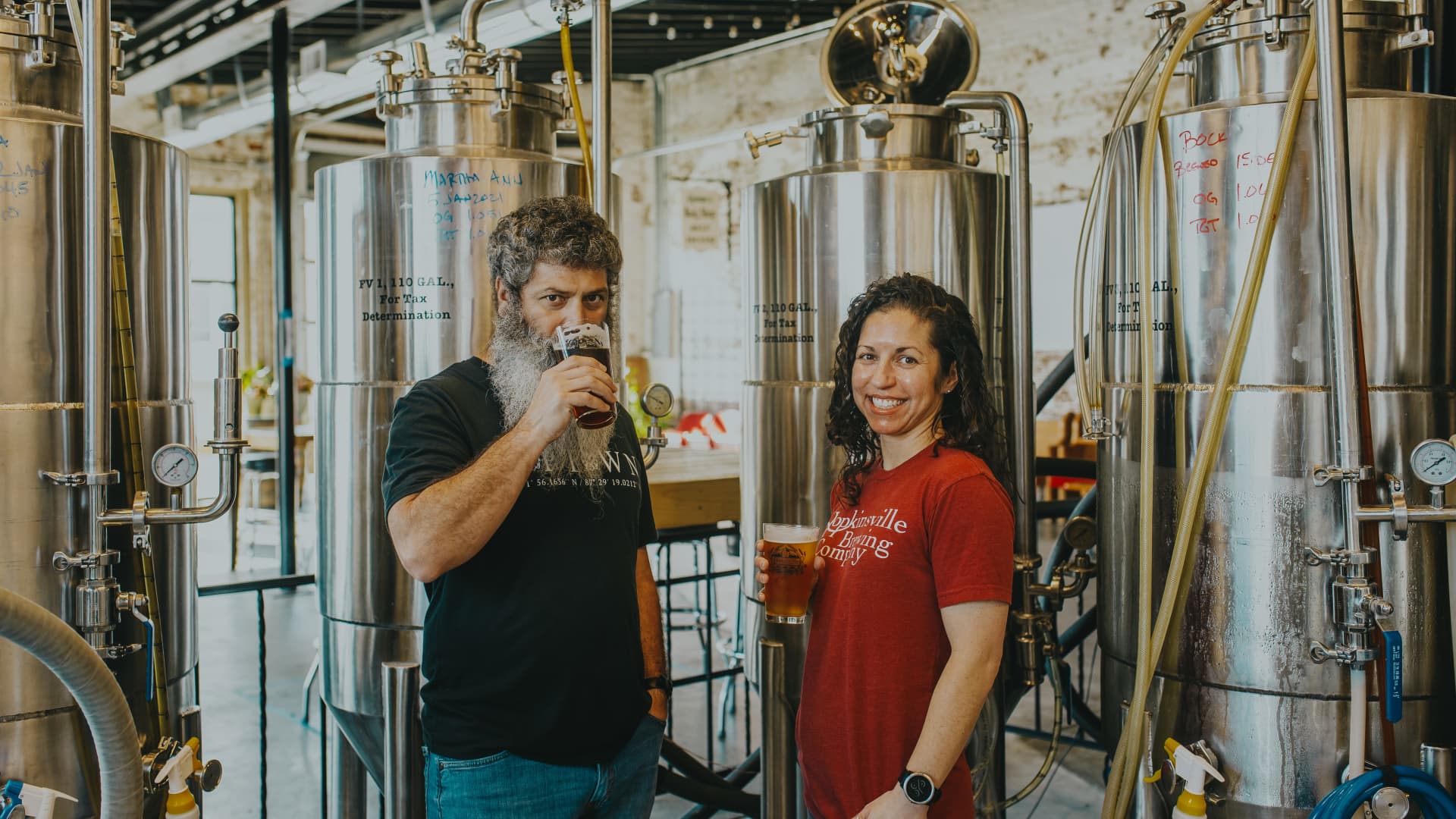Products You May Like
Small business owners have had a few rough years.
First, the Covid-19 pandemic caused many to lose revenue. Now, they’re dealing with higher costs as inflation rises.
The consumer price index, which measures the prices of goods and services, increased 8.5% in March from a year ago, while the producer price index, which measures prices paid by wholesalers, jumped 11.2% year over year in March.
For Kate Russell, 40, co-owner of Kentucky-based Hopskinsville Brewing Company, that means everything from equipment and aluminum to grain and fuel has gotten more expensive.
On average, her total costs have gone up about 15% to 20%.
“We sat on that as long as we could before we finally had to just break down and raise prices,” she said. “We felt really bad about that. We still feel very bad about that.”
Inflation, as well as supply-chain issues and workforce challenges, are weighing heavily on businesses. Some 91% said these broader economic trends are having a negative impact on their business, according to a survey of 1,107 small business owners from Goldman Sachs 10,000 Small Businesses Voices. Fully 73% said increasing energy costs are having negative impacts on their bottom lines.
However, like Russell, small business owners are hesitant to raise prices, according to the latest CNBC|SurveyMonkey Small Business Survey for Q2 2022.
Some 75% said they are currently experiencing a rise in the cost of their supplies, yet only 40% are increasing prices. That’s down from the 47% of owners who adjusted prices in the first quarter.
Still, passing the cost on to consumers is the main tool small business owners are turning to, a separate survey by the National Federation of Independent Business found. They are also absorbing some of the higher costs. Some 31% are taking on debt.
“Inflation is a new challenge for most small business owners that are currently operating,” said Holly Wade, executive director of the NFIB Research Center.
“They’re finding it incredibly difficult to navigate having to absorb these increased prices, and also anticipating how long these price increases might last,” Wade added.
More from Invest in You:
How small businesses can avoid financial missteps
What Americans plan to spend more money on prices go higher
Employers boost mental wellness benefits amid the Great Resignation
Small-business owners are also getting creative, looking for alternative solutions, such as reducing the quantity of goods and services offered to help stabilize costs, the survey found.
It’s something Jennifer Glanville, director of partnerships and collaborations at Boston Beer Company, sees in her role as head of the company’s Brewing the American Dream program.
The initiative partners with nonprofit lenders to help with access to capital and also offers one-on-one coaching for small business owners. Recently, the focus as been on helping them navigate higher costs.
“Consumers are expecting to spend more whether we like it or not, but it’s really how we how we can help position these businesses for success around that and keeping some of their other costs down,” Glanville said.
That can mean looking for efficiencies with ordering and networking as a way to find support and perhaps products and services at a reduced cost, she said.
I was pretty certain we would start losing employees if we didn’t act in a real definitive way.Mindy GoddingCo-founder of Abundance Organizing
For her part, Russell is now looking at possibly cutting back on live entertainment and trivia nights to reduce expenses. She and her partner have also taken pay cuts.
Fortunately, costumers aren’t really complaining about the increase in prices, she said, since it’s happening across the board in the economy. What they do talk about is the incredible run up in gas prices, which were up 18.3% in March from the month prior, and 48% from the previous year, the Labor Department’s CPI data show.
That’s what is really impacting Mindy Godding, co-founder of in-home organization company Abundance Organizing, based in Richmond, Virginia. Her employees can commute up to an hour to a job. They soon found themselves spending $50 to $70 to fill up their tank.
“They were really feeling pinched and frustrated,” said Godding, who co-founded the business in 2010.
“I was pretty certain we would start losing employees if we didn’t act in a real definitive way,” she added.
As a band-aid, she gave employees $25 gas gift cards. A few weeks later, the company boosted the wages of their workers in the field by 25% to 30%, Godding said. To pay for it, she raised prices to consumers.
Not only are there higher prices and labor issues, but rising interest rates are also putting the brakes on some long-term goals she had planned, like buying a new vehicle.
“We are really getting the triple whammy right now,” Godding said. “It feels like we are being squeezed in every direction.”
Yet for those who navigated the pandemic, they’ve already learned how to pivot and survive.
“They’ve been through so much in the past 24 months,” Glanville said.
“Their ability to be creative and innovative around their business and the business needs have actually set many of these businesses up for success, even with inflation as it is.”
SIGN UP: Money 101 is an 8-week learning course to financial freedom, delivered weekly to your inbox. For the Spanish version Dinero 101, click here.
CHECK OUT: 3 side hustles for night owls: One can pay as much as $40/hour with Acorns+CNBC
Disclosure: NBCUniversal and Comcast Ventures are investors in Acorns.
